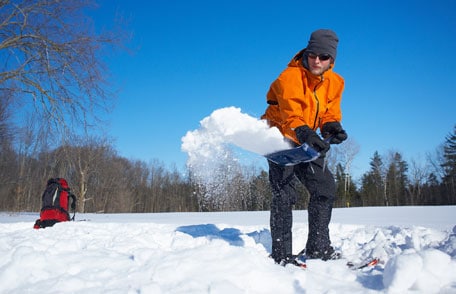When Working in the Cold, Be Prepared and Be Aware

When you must work in the cold, always be prepared and be aware.
Workers in cold environments may be at risk of cold stress. Exposure to cold can be an uncomfortable and potentially dangerous situation. For outdoor workers, what constitutes cold stress and its effects can vary across different areas of the country. In regions where workers are unaccustomed to winter weather, near freezing temperatures are considered factors for cold stress. Whenever outdoor temperatures drop significantly below normal and wind speed increases, heat more rapidly leaves the body. Serious health problems can occur when the body is unable to stay warm enough.
When you must work in the cold, always be prepared and be aware.
Be Prepared
Be prepared by wearing warm clothing. Workers who must be in the cold should wear warm clothing that is right for the weather. Wear several layers of loose clothing. Layering provides better insulation. Wear gloves to protect the hands, and a hat and/or hood to protect the head. In wet conditions, wear waterproof shoes that have good traction. Make sure that your cold weather gear does not restrict your movement or block your eyesight.
Be prepared to limit your time outside. Take breaks in warm locations, such as inside a vehicle or other sheltered or heated area. Workers may also need to limit their time outside on extremely cold days, so cold jobs should be scheduled for the warmest part of the day and relief workers may need to be assigned for long jobs. Be prepared for working in the cold, even if the cold temperatures are not extreme. It is obvious that bitter cold and howling winds can harm you, but did you know that you could suffer cold-related illness and injuries when it is as warm as 60° F?
Be Aware
Be aware that cold temperatures can lead to illness and injury. Workers should monitor their physical condition and that of coworkers, and immediately report signs and symptoms of cold-related illnesses and injuries to their supervisors or medical staff.
Hypothermia
One of the biggest dangers from working in the cold can be the hardest to recognize. Hypothermia happens when your body temperature drops because body heat is being lost faster than it can be produced. Mild hypothermia can make you feel confused, and you may not realize anything is wrong until it is too late. Being too cold can also cloud your judgment and cause you to make mistakes while you work, and mistakes can sometimes be deadly.
Early symptoms of hypothermia include shivering, feeling tired, loss of coordination, and confusion. As your body loses more heat, the shivering will stop, your skin may turn blue, the pupils of your eye will dilate, your pulse and breathing will slow, and you will lose consciousness.
Frostbite
Many parts of the body are prone to frostbite, including your fingers, toes, nose, and ears. Frostbite happens when a part of the body freezes, damaging the tissue. With severe damage, the body part may need to be removed to prevent even worse health problems. Warning signs of frostbite include numbness or tingling, stinging, or pain on or near the affected body part. Avoid frostbite by being aware of the weather and wearing protective clothing such as warm gloves, insulated shoes, and warm hats.
Other Cold Weather Injuries
You can get trench foot when your feet are wet and cold for too long. Moisture causes your feet to lose heat, and this can slow the blood flow and damage tissue. Trench foot can happen when it is as warm as 60° F.
Sometimes cold weather can damage your skin and cause chilblains. This problem can cause broken skin, swelling, blisters, redness, and itching.
For more information about hypothermia and other cold weather injuries, see the NIOSH Fast Facts card, Protecting Yourself from Cold Stress.
Be Ready for the Cold
If you have to work in the cold, always wear clothing that is appropriate for the weather. Remember prolonged exposures to cold temperatures could cause you to make poor decisions or react more slowly than normal. Tell your supervisor if you are not dressed warmly enough. Pay attention to warning signs and symptoms of hypothermia, frostbite, and other cold-related illnesses and injuries.
Additional resource: NIOSH Cold Stress























.png)











No hay comentarios:
Publicar un comentario